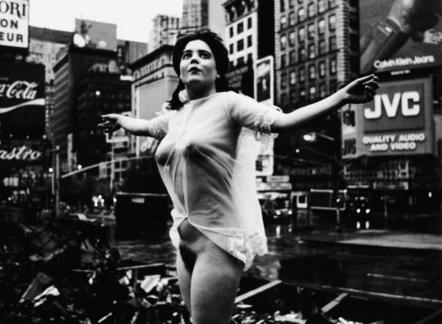MIRON ZOWNIR - RADICAL EYE
PhotographsPreview: Saturday 27th October 7:30 - 10pm
Monday 29th October - Saturday 17th November
Mon - Sat 12 - 6pm
Sunday 28th October 5pm
Special screening of Miron Zownir's films + Q&A with artist
Friday 9th November 7:30pm
£7/£5 members & concessions
Further screening of Miron Zownir's films
(watch this space for more details as they emerge)
 New York 1982
In a walk on the wild side that spans over thirty years, and has taken in periods spent in New York, Moscow and Berlin, German photographer Miron Zownir has recorded countless arresting images of human desolation and decline. Drawn to the margins and extremes of society, he sought out the damned and the dispossessed in the shadows of the city - the whores, bums, junkies and transsexuals. The freaks and outcasts who had no place to go.
'I am drawn to people who are 'lost', in an existential or metaphysical way,' he explains. 'If you are lost, you move in your own world, blocking out the outside, but looking for something to connect with. I have an empathy for these kind of people, for their emotional condition and the vulnerability they reveal in that state.'
Zownir also moves in his own world, one as acutely-focused and defined in theme and subject matter as those of his favourite photographers, Weegee, Diane Arbus and Robert Frank. His pictures are usually shot in black and white - all the better to emphasize the extremes and the grey area in-between - and marked by the kind of cold, blank stare usually associated with film noir.
Born in Karlsruhe, South-West Germany in 1953 to a German mother and a Ukrainian father, Zownir was raised by his grandparents until he was five years old, an experience pivotal to his own sense of estrangement. His first impulse was to write and make films. But after failing to get a place at the Berlin Film Academy, he moved to London (in 1978), where he took up photography out of a need to engage with unfamiliar surroundings.
He emigrated to the US in 1981, spent 15 years living hand-to-mouth. In New York, he worked the door at decadent 80s clubs like Danceteria and Mudd Club and, camera in hand, stalked the slums of the city after hours. In 1995, he spent several months in Russia capturing images from the street of the social vacuum left after the fall of Communism. On returning to Germany, he published a retrospective book called Radical Eye, and now lives in Berlin, where he has written crime novels and made films (including Estrangement Is Death, an award-winning documentary about artist and musician Bruno S, best-known as a star in 70s films by Werner Herzog).
- Chris Campion
www.mironzownir.com
New York 1982
In a walk on the wild side that spans over thirty years, and has taken in periods spent in New York, Moscow and Berlin, German photographer Miron Zownir has recorded countless arresting images of human desolation and decline. Drawn to the margins and extremes of society, he sought out the damned and the dispossessed in the shadows of the city - the whores, bums, junkies and transsexuals. The freaks and outcasts who had no place to go.
'I am drawn to people who are 'lost', in an existential or metaphysical way,' he explains. 'If you are lost, you move in your own world, blocking out the outside, but looking for something to connect with. I have an empathy for these kind of people, for their emotional condition and the vulnerability they reveal in that state.'
Zownir also moves in his own world, one as acutely-focused and defined in theme and subject matter as those of his favourite photographers, Weegee, Diane Arbus and Robert Frank. His pictures are usually shot in black and white - all the better to emphasize the extremes and the grey area in-between - and marked by the kind of cold, blank stare usually associated with film noir.
Born in Karlsruhe, South-West Germany in 1953 to a German mother and a Ukrainian father, Zownir was raised by his grandparents until he was five years old, an experience pivotal to his own sense of estrangement. His first impulse was to write and make films. But after failing to get a place at the Berlin Film Academy, he moved to London (in 1978), where he took up photography out of a need to engage with unfamiliar surroundings.
He emigrated to the US in 1981, spent 15 years living hand-to-mouth. In New York, he worked the door at decadent 80s clubs like Danceteria and Mudd Club and, camera in hand, stalked the slums of the city after hours. In 1995, he spent several months in Russia capturing images from the street of the social vacuum left after the fall of Communism. On returning to Germany, he published a retrospective book called Radical Eye, and now lives in Berlin, where he has written crime novels and made films (including Estrangement Is Death, an award-winning documentary about artist and musician Bruno S, best-known as a star in 70s films by Werner Herzog).
- Chris Campion
www.mironzownir.com
